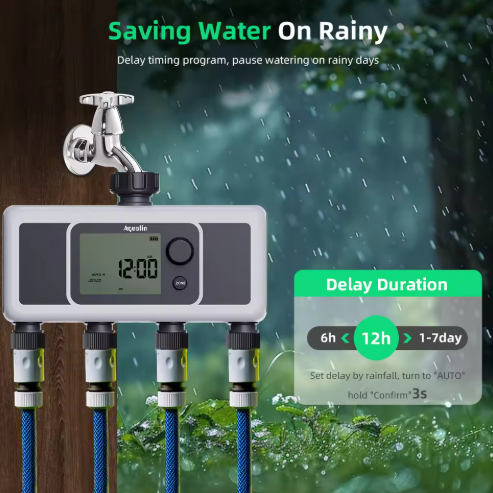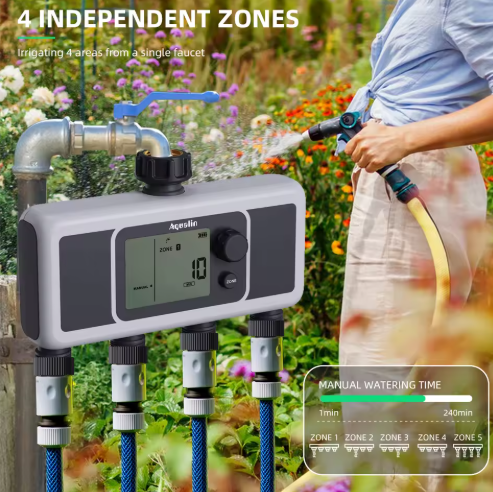풍성한 정원을 위한 스마트 관개 솔루션
현대 원예는 수동 급수 방식을 넘어섰으며, 물 타이머 가 활력 있는 잔디와 건강한 식물을 유지하는 데 필수적인 도구로 자리 잡고 있습니다. 이러한 지능형 장치들은 가정 소유자와 원예 애호가들이 관개를 수행하는 방식을 혁신적으로 변화시켰으며, 식물 관리에서 정밀성, 편의성, 뛰어난 결과를 제공합니다. 워터 타이머 물 타이머는 정원의 신뢰할 수 있는 관리자 역할을 하며, 일관된 급수를 보장하고 물의 지속 가능한 사용을 촉진합니다.
물 타이머를 통한 자동 관개의 영향은 단순한 편의성을 훨씬 뛰어넘습니다. 이러한 장치들은 이상적인 시간에 정확한 양의 물을 공급함으로써 최적의 성장 환경을 조성하여 뿌리 시스템을 더욱 강화하고 식물을 더 탄력 있게 만듭니다. 작은 허브 정원을 관리하든 광범위한 경관을 유지하든, 물 타이머 기술을 어떻게 활용할 수 있는지 이해하는 것은 여러분의 원예 성공을 변화시킬 수 있습니다.
물 타이머 기술 이해하기
핵심 구성 요소 및 기능
물 타이머는 핵심적으로 여러 정교한 구성 요소가 조화를 이루어 작동합니다. 주요 메커니즘에는 프로그래밍 가능한 인터페이스, 물 흐름 제어 밸브 및 타이밍 회로가 포함됩니다. 최신 물 타이머는 습도 감지, 비 올 때 자동 연기 기능, 무선 연결 기능과 같은 추가 기능을 종종 포함하고 있습니다. 센서 이러한 요소들은 정확한 급수 일정을 실행하여 식물이 최적의 수분을 받을 수 있도록 서로 협력하여 작동합니다.
첨단 물 자동 조절 장치는 기상 모니터링 기능을 포함하여 환경 조건에 따라 급수 주기를 조정할 수 있습니다. 이러한 스마트한 적응 기능은 비가 많이 오는 기간 동안의 과도한 관수를 방지하고 가뭄 시에는 물 공급을 늘려주므로 매우 효율적인 정원 관리 도구가 됩니다.
사용 가능한 물 자동 조절 장치의 종류
시장에서는 다양한 원예 요구에 맞는 다양한 물 자동 조절 장치 모델을 제공합니다. 기계식 타이머는 간단한 다이얼 조작으로 기본 예약 기능을 제공하며, 단순한 관개 작업에 이상적입니다. 디지털 물 자동 조절 장치는 더 정교한 프로그래밍 옵션을 제공하여 여러 개의 일정과 존(zones) 제어가 가능합니다. 스마트 물 자동 조절 장치는 최신 혁신 기술을 반영하여 앱 연동, 실시간 모니터링 및 기상 데이터에 기반한 자동 조정 기능을 갖추고 있습니다.
배터리 구동 장치는 설치 위치의 유연성을 제공하며, 하드와이어 방식 모델은 배터리 걱정 없이 지속적인 작동을 보장합니다. 일부 물 자동제어장치는 태양광 패널과 함께 제공되어 환경 친화성과 실용적인 기능을 결합합니다.

물 자동제어장치 설치의 이점
물 절약 및 비용 절감
물 자동제어장치를 설치하면 물 사용량을 크게 줄이고 공과금 부담도 완화할 수 있습니다. 이러한 장치는 물 주는 시간과 빈도에서 발생할 수 있는 인간의 실수를 제거하여 무분별한 과잉 급수를 방지합니다. 연구에 따르면 물 자동제어장치가 장착된 자동 관개 시스템은 수동 급수 방법 대비 최대 30%까지 물 소비를 줄일 수 있습니다.
경제적 이점은 물 절약을 넘어서 확장됩니다. 정확한 양의 물을 공급함으로써 이러한 장치는 과수 또는 급수가 부족하여 식물이 손실되는 것을 방지하고, 교체용 식물과 유지 관리 비용을 줄이는 데 도움을 줍니다. 많은 지역에서는 물 사용 효율적인 관개 시스템 설치 시 환급금이나 인센티브를 제공하기 때문에 물 타이머는 더욱 매력적인 투자가 됩니다.
식물 건강 및 생장 향상
물 타이머를 통해 설정된 일관된 급수 일정은 식물의 최적 건강을 촉진합니다. 식물은 규칙적인 급수에 잘 자라며, 이러한 장치는 매일 동일한 시간에 물을 공급하여 적절한 영양분 흡수와 뿌리 발달을 보장합니다. 이러한 일관성은 특히 중요한 생장 단계와 계절 변화 시기에 매우 중요합니다.
급수 타이머는 이상적인 토양 수분 수준을 유지하는 데 도움이 되어 불규칙한 수동 급수로 인해 발생하는 스트레스 주기를 방지합니다. 이러한 안정성은 더 강력한 뿌리계, 향상된 병해 저항성, 그리고 더욱 생기 있는 꽃이나 잎 성장을 가져옵니다. 수동 관개에 의존하는 정원과 비교할 때, 급수 타이머를 사용하여 관리하는 정원은 일반적으로 개선된 생장 속도와 전반적인 활력을 보입니다.
급수 타이머 설정 최적화
계절별 조정 전략
효율적인 급수 타이머 관리를 위해서는 연중에 걸쳐 설정을 조정해야 합니다. 봄철에는 식물이 휴면 상태에서 깨어나기 때문에 적당한 급수가 필요합니다. 여름철 설정은 증가된 증발량과 식물의 물 필요량을 반영해야 하며, 가을과 겨울에는 일반적으로 급수 빈도를 줄여야 합니다. 급수 타이머를 이러한 계절 변화에 맞게 프로그래밍하면 자원의 최적 사용과 식물 건강을 보장할 수 있습니다.
물 공급 타이머 설정을 조정할 때는 강우 패턴, 기온 변화, 일조 시간과 같은 요소들을 고려하세요. 많은 최신 장비들은 계절 조정 기능을 제공하여 물 주는 빈도는 동일하게 유지하면서 자동으로 급수 시간을 조절합니다.
식물별 프로그래밍
다양한 식물은 각기 다른 물 요구량을 가지며, 물 공급 타이머는 이러한 요구에 맞게 프로그래밍할 수 있습니다. 깊은 뿌리를 가진 식물은 덜 빈번하지만 더 긴 급수 사이클에서 이점을 얻는 반면, 얕은 뿌리를 가진 식물은 짧고 더 자주 급수받는 것을 선호합니다. 식물의 물 필요량에 따라 존(zone)을 나누면 각 식물 유형의 성장을 최적화할 수 있는 맞춤형 관개 프로그램을 만들 수 있습니다.
급수 프로그램을 설정할 때 토양 종류, 식물의 생육 단계, 소규모 기후 조건 등을 고려하세요. 일부 물 공급 타이머는 다중 프로그램을 지원하여 정원의 서로 다른 구역이나 다양한 식물 종류에 맞춘 개별 스케줄을 생성할 수 있게 해줍니다.
유지 보수 및 문제 해결
정기적인 유지보수 절차
물 타이머의 정기적인 유지보수는 안정적인 작동과 장치 수명 연장을 보장합니다. 정기 점검에는 필터 청소, 누수 여부 확인 및 배터리 구동 모델의 배터리 잔량 점검이 포함되어야 합니다. 계절별 유지보수로는 미네랄 침전물 확인, 모든 기능 테스트 및 필요 시 프로그래밍 업데이트를 수행해야 합니다.
유지보수 활동 및 설정 기록은 시스템 성능 추적과 문제 진단에 도움을 줍니다. 배터리 교체, 필터 청소, 프로그래밍 조정 내역을 기록하여 효과적인 유지보수 루틴을 수립하세요.
일반적인 문제점 및 해결책
물 타이머는 가끔 프로그래밍 오류, 밸브 고착 또는 연결 문제와 같은 문제가 발생할 수 있습니다. 일반적인 문제와 해결 방법을 이해하면 지속적인 작동을 유지하는 데 도움이 됩니다. 물 압력, 연결 부위 및 타이머 기능을 정기적으로 점검하면 정원에 영향을 미치기 전에 많은 문제를 예방할 수 있습니다.
문제 해결 시 배터리 상태 및 프로그래밍 확인과 같은 간단한 점검부터 시작한 후 더 복잡한 문제로 넘어가세요. 많은 최신 물 자동 조절 장치는 진단 기능을 포함하고 있어 문제를 빠르게 파악하는 데 도움이 됩니다.
자주 묻는 질문
물 자동 조절 장치의 배터리는 일반적으로 얼마나 오래 지속되나요?
물 자동 조절 장치의 배터리 수명은 모델과 사용 빈도에 따라 다르지만, 일반적으로 6개월에서 1년 정도입니다. 표준 물 자동 조절 장치에 사용되는 고품질 알칼리 배터리는 재배 시즌 동안 안정적인 작동을 제공합니다. 일부 스마트 물 자동 조절 장치는 무선 연결 기능으로 인해 전력 소비가 많아져 배터리를 더 자주 교체해야 할 수 있습니다.
물 자동 조절 장치는 영하 온도에서도 작동할 수 있나요?
많은 물 자동 타이머들이 다양한 기상 조건을 견딜 수 있도록 설계되어 있지만, 대부분은 동결로 인한 손상을 방지하기 위해 영하의 온도가 지속될 경우 실외에서 제거하여 실내에 보관하는 것이 좋습니다. 일부 고급 모델은 동결 감지 센서와 자동 종료 기능을 갖추고 있지만, 기온이 일정하게 영하로 떨어질 때는 물 자동 타이머를 포함한 관개 시스템 전체를 동절기용으로 점검하고 준비하는 것이 가장 바람직한 방법입니다.
정전 시 물 자동 타이머는 계속 작동할 수 있나요?
배터리로 작동하는 물 자동 타이머는 정전 중에도 프로그래밍된 스케줄을 유지하며 계속 작동합니다. 전선 연결형 모델은 일반적으로 설정을 저장하고 정전 중에도 기본 기능을 유지할 수 있는 배터리 백업 시스템을 포함하고 있습니다. 스마트 물 자동 타이머는 연결이 끊어질 경우 일부 고급 기능을 잃을 수 있으나 기본적인 물 공급 기능은 유지되어야 합니다.


